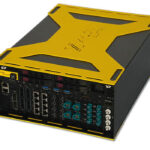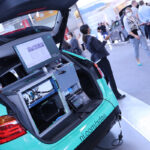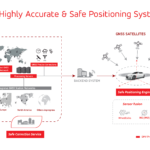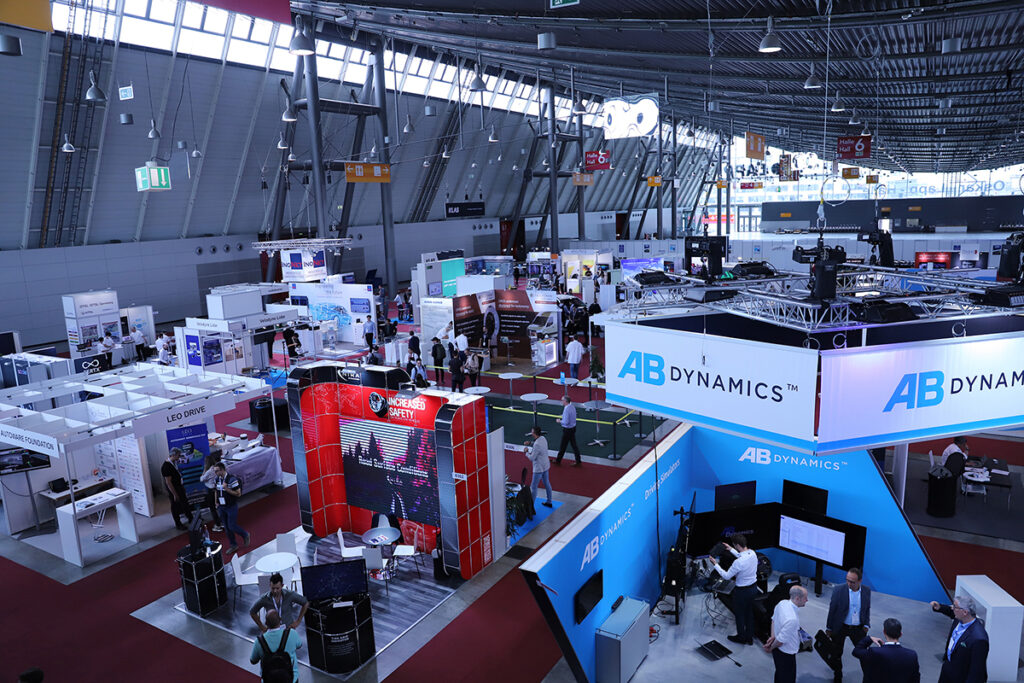The leading exhibition in Europe for ADAS and AV development will once again welcome companies specializing in sensors, simulation, mapping, positioning, data capture, labelling, testing, AI and sensor fusion – in fact anything required for ADAS, automated driving and software-defined vehicles – to the Stuttgart Messe on June 13, 14 and 15, 2023, for ADAS & Autonomous Vehicle Technology Expo 2023.
Taking place alongside Automotive Testing Expo, this year’s ADAS & Autonomous Vehicle Technology Expo Europe is set to be the biggest yet, with visitors able to meet more than 150 exhibitors from around the world, showcasing the latest solutions to enable and accelerate autonomous and ADAS applications across two halls at Stuttgart Messe. Both shows are completely free to attend, bringing together thousands of international visitors with the industry’s leading ADAS and autonomous tech suppliers, all in one dedicated meeting place. Register for your free fast-track entry code, here. And read AAVI’s dedicated preview, here.
WHAT’S ON SHOW
 Early exhibitor news includes Xylon’s new Quattro datalogger and HIL system, which has been designed to support automotive development and testing up to L5 autonomy and offering 128Gbps of datalogging and playback bandwidth and 128TB of internal data storage, as well as an open software architecture and HIL capabilities. Xylon Quattro directly connects up to 16 video cameras, with resolutions up to 32MP, via current LVDS interfaces such as GMSL2 and FPD-Link III. Quattro will also support upcoming interfaces including FPD-Link IV, MIPI A-Phy, etc.
Early exhibitor news includes Xylon’s new Quattro datalogger and HIL system, which has been designed to support automotive development and testing up to L5 autonomy and offering 128Gbps of datalogging and playback bandwidth and 128TB of internal data storage, as well as an open software architecture and HIL capabilities. Xylon Quattro directly connects up to 16 video cameras, with resolutions up to 32MP, via current LVDS interfaces such as GMSL2 and FPD-Link III. Quattro will also support upcoming interfaces including FPD-Link IV, MIPI A-Phy, etc.
 Formerly known as National Instruments, NI will introduce the NI-Aliaro HIL system, a hardware-in-the-loop system designed to improve the efficiency of automotive electronics testing and built to accelerate the validation of multi-domain and zonal controller architectures for software-designed vehicles. The company’s technology and workflow demonstrations for ADAS/AD also include in-vehicle data record, data ingest and a unified solution for ADAS replay and HIL, paving the way toward Vision Zero. Connecting test data and test methodologies while increasing their utilization throughout the different stages of the product development cycle (V-model) is a key focus area for NI.
Formerly known as National Instruments, NI will introduce the NI-Aliaro HIL system, a hardware-in-the-loop system designed to improve the efficiency of automotive electronics testing and built to accelerate the validation of multi-domain and zonal controller architectures for software-designed vehicles. The company’s technology and workflow demonstrations for ADAS/AD also include in-vehicle data record, data ingest and a unified solution for ADAS replay and HIL, paving the way toward Vision Zero. Connecting test data and test methodologies while increasing their utilization throughout the different stages of the product development cycle (V-model) is a key focus area for NI.
 rFpro will display a new simulation technology that considerably reduces the industry’s dependence on real-world testing for the development of autonomous vehicles and ADAS. The company’s new ray-tracing rendering solution is the first to accurately simulate how a vehicle’s sensor system perceives the world. The ray-tracing engine is a software-in-the-loop (SIL) solution aimed at generating synthetic training data. It uses multiple light rays through the scene to accurately capture all the nuances of the real world. As a multipath technique, it can reliably simulate the huge number of reflections that happen around a sensor. This is critical to accurately portray reflections and shadows in low-light scenarios or environments where there are multiple light sources.
rFpro will display a new simulation technology that considerably reduces the industry’s dependence on real-world testing for the development of autonomous vehicles and ADAS. The company’s new ray-tracing rendering solution is the first to accurately simulate how a vehicle’s sensor system perceives the world. The ray-tracing engine is a software-in-the-loop (SIL) solution aimed at generating synthetic training data. It uses multiple light rays through the scene to accurately capture all the nuances of the real world. As a multipath technique, it can reliably simulate the huge number of reflections that happen around a sensor. This is critical to accurately portray reflections and shadows in low-light scenarios or environments where there are multiple light sources.
 A provider of high-accuracy, safe and reliable positioning services, GMV will present ‘GSharp for Automotive’ at this year’s show. This solution comprises onboard positioning engine (PE) software and a GNSS correction service (CS). Integrated with other in-vehicle sensors, these optimize the end user performance for automated driving. GMV also offers telematics solutions for connected vehicles, including the European eCall, SVT and mobility solutions for cooperative services (C-ITS) and e-tolling. Additionally, the company provides cybersecurity services for connected autonomous vehicles, supported by its solid background in cybersecurity.
A provider of high-accuracy, safe and reliable positioning services, GMV will present ‘GSharp for Automotive’ at this year’s show. This solution comprises onboard positioning engine (PE) software and a GNSS correction service (CS). Integrated with other in-vehicle sensors, these optimize the end user performance for automated driving. GMV also offers telematics solutions for connected vehicles, including the European eCall, SVT and mobility solutions for cooperative services (C-ITS) and e-tolling. Additionally, the company provides cybersecurity services for connected autonomous vehicles, supported by its solid background in cybersecurity.
 IPG will demo CarMaker 12, which features enhanced new functions in scenario generation to make virtual test driving even more realistic. Using its import and export function, road networks can be divided into individual segments and exported separately. Using the software has never been easier, thanks to increased compatibility with the OpenSCENARIO standard and a configurable, central ground truth sensor that offers a multitude of data access options. In addition, a new battery model and a reviewed modular powertrain architecture enable the use of CarMaker 12 for applications with hybrid and electrified powertrains.
IPG will demo CarMaker 12, which features enhanced new functions in scenario generation to make virtual test driving even more realistic. Using its import and export function, road networks can be divided into individual segments and exported separately. Using the software has never been easier, thanks to increased compatibility with the OpenSCENARIO standard and a configurable, central ground truth sensor that offers a multitude of data access options. In addition, a new battery model and a reviewed modular powertrain architecture enable the use of CarMaker 12 for applications with hybrid and electrified powertrains.
DEDICATED CONFERENCE
A dedicated conference (rates apply) will be held alongside the exhibition, and will feature over 120 speakers, including experts from AWS, Bosch, Continental, IBM, Microsoft, Plus, Renault, Stellantis, Torc Robotics, and Volkswagen Commercial Vehicles. Delegates will gain exclusive insights from the latest case studies and live trials, software and hardware developments, program announcements, safety and simulation strategies, and testing results. For full details of the conference program, click here; and reserve your place at the conference, by clicking here.
 Conference highlights include a presentation on Sustainable software architecture development for future vehicles from Aptiv’s Dr Florian Baumann. “The presentation will discuss how to reduce complexity and interdependencies among the many different ECUs, unite applications to unlock new software-enabled functionality and control the software that defines the user experience of vehicles,” he says. “It will also outline a standard-based approach for interfaces, which improves reuse and creates an open platform for innovation.”
Conference highlights include a presentation on Sustainable software architecture development for future vehicles from Aptiv’s Dr Florian Baumann. “The presentation will discuss how to reduce complexity and interdependencies among the many different ECUs, unite applications to unlock new software-enabled functionality and control the software that defines the user experience of vehicles,” he says. “It will also outline a standard-based approach for interfaces, which improves reuse and creates an open platform for innovation.”
 Tine Damkjaer of the Danish Road Directorate will ask, Are road markings good enough for future driving? “Road markings are essential to ensure good driving conditions,” she says. “Traditionally, the characterization of the road marking has been standardized by visibility of the human drivers. However, AV technology relies on a machine perception of road markings. This raises the question whether the current standards and models need to be adapted to enable a sufficient quality for detection of AVs. This presentation summarizes the result of two projects which investigate what affects the detection, and the road authorities’ need for maintenance of the road infrastructure to meet the demands of the future with automated driving.”
Tine Damkjaer of the Danish Road Directorate will ask, Are road markings good enough for future driving? “Road markings are essential to ensure good driving conditions,” she says. “Traditionally, the characterization of the road marking has been standardized by visibility of the human drivers. However, AV technology relies on a machine perception of road markings. This raises the question whether the current standards and models need to be adapted to enable a sufficient quality for detection of AVs. This presentation summarizes the result of two projects which investigate what affects the detection, and the road authorities’ need for maintenance of the road infrastructure to meet the demands of the future with automated driving.”
 Meanwhile ASAM eV’s CTO, Benjamin Engel will present, ASAM: Painting our standards into a bigger picture.”Standards are playing an ever increasingly important role in enabling the shift from monolithic to modular toolchains in the industry but they are only part of the picture,” he explains. “We need to take into account additional aspects such as comparability, traceability and consistency, both of data and of the use of the standards themselves, in order to fully enable safe V&V of highly automated driving functions. In this presentation we will show what else we are doing in ASAM and together with other organizations in the industry to achieve this.”
Meanwhile ASAM eV’s CTO, Benjamin Engel will present, ASAM: Painting our standards into a bigger picture.”Standards are playing an ever increasingly important role in enabling the shift from monolithic to modular toolchains in the industry but they are only part of the picture,” he explains. “We need to take into account additional aspects such as comparability, traceability and consistency, both of data and of the use of the standards themselves, in order to fully enable safe V&V of highly automated driving functions. In this presentation we will show what else we are doing in ASAM and together with other organizations in the industry to achieve this.”
 Camilla Fowler, Oxbotica’s head of safety assurance, will advise on Preparing for safe commercial deployment of automated vehicles. “Oxbotica is advancing self-driving capabilities through the development and implementation of three key products: Oxbotica Driver, Oxbotica Cloud and MetaDriver,” she says. “This presentation will outline how we are preparing for the safe and successful commercial deployment of these products and will offer insights into our safety management system, preparing for regulatory authorization and ensuring continued safety throughout operations.”
Camilla Fowler, Oxbotica’s head of safety assurance, will advise on Preparing for safe commercial deployment of automated vehicles. “Oxbotica is advancing self-driving capabilities through the development and implementation of three key products: Oxbotica Driver, Oxbotica Cloud and MetaDriver,” she says. “This presentation will outline how we are preparing for the safe and successful commercial deployment of these products and will offer insights into our safety management system, preparing for regulatory authorization and ensuring continued safety throughout operations.”
 Michele Richichi, who has previously held roles responsible for ADAS development at Stellantis, Maserati and FCA, is now Standard & Poor’s global mobility division’s principal research analyst for market intelligence on autonomy in Europe. Michele will present on the latest Autonomy market mega-trends: “Autonomy content value per vehicle will increase substantially by a factor of three from today to 2034,” he says. “However, different regions will experience different changes. European requirements mean more ADAS in every vehicle, while China and the USA are pushing into new technology and use cases with the support of a new generation of suppliers. Still, the challenging macroeconomic environment means struggle, consolidation, and shifting expectations and timelines.”
Michele Richichi, who has previously held roles responsible for ADAS development at Stellantis, Maserati and FCA, is now Standard & Poor’s global mobility division’s principal research analyst for market intelligence on autonomy in Europe. Michele will present on the latest Autonomy market mega-trends: “Autonomy content value per vehicle will increase substantially by a factor of three from today to 2034,” he says. “However, different regions will experience different changes. European requirements mean more ADAS in every vehicle, while China and the USA are pushing into new technology and use cases with the support of a new generation of suppliers. Still, the challenging macroeconomic environment means struggle, consolidation, and shifting expectations and timelines.”
EXCLUSIVE WORKSHOP
Conference delegates can also book a place at an exclusive lunchtime workshop presented by Volkswagen Commercial Vehicles, providing hands-on operational design domain (ODD) specification and evaluation advice. Taking place from 1:00pm to 2:00pm on Tuesday, June 13, the workshop will be led by Dr Andreas Richter, engineering program manager of operational design domains, Volkswagen Commercial Vehicles, who is also presenting a paper titled ‘Operational design domain between the poles of development, approval and operations’ at the conference on the same day. Read an exclusive interview with Dr Richter, here.



